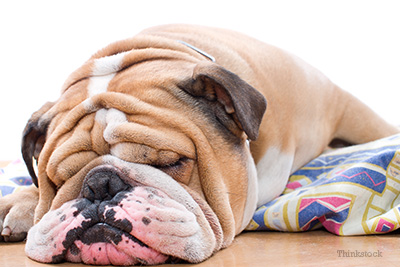
Some dogs, generally of a specific body type, have excessive folds and wrinkles in their skin. This can occur as a result of obesity or in some breeds, for example bulldogs, it can be a normal variation. Even dogs that have recently lost weight may have residual excess skin that causes deep folds.
In all of these situations, these areas of skin are prone to problems that arise from a combination of rubbing, heat and moisture; they are predisposed to pyoderma (infection).
What causes skin fold pyodermas?
The deep folds in these dogs result from a lack of muscle beneath the skin and an excess of skin that develops, especially over the front of the face. Other areas of the body prone to excess skin include:
- Lip folds
- Arm pit areas
- Peri-vulvar areas
- The base of the tail
Unfortunately, these wrinkles and folds result in a warm and moist environment that can lead to the growth of bacteria and yeast. In turn the bacteria and yeast may invade the skin and cause pyodermas. Antibiotics, local cleansing and drying may help but they do nothing to treat the underlying cause.
Will skin fold pyodermas affect my dog?
In some breeds, exuberant folds and wrinkles are a breed characteristic; it’s somewhat desirable but makes pyodermas more likely nonetheless. Bulldogs are one example. Most people apply the term “bulldog” to a particular variety of bulldog properly called the English Bulldog or British Bulldog. Other bulldog breeds include the American Bulldog, Olde English Bulldog and the French Bulldog.
Other breeds that have shortened muzzles (brachycephalic breeds) like the Boston Terrier, Pekingese, Shih Tzu, Pug and King Charles Spaniel also often have very deep facial folds.
As I mention above, overweight dogs or dogs that have recently lost weight could be at greater risk too. Click here for 5 must ask questions about pet obesity.
Prevention of skin fold pyodermas
- One step that is often overlooked is simple weight control. A few pounds can do a lot to reduce the prominence of body folds.
- Discuss any areas that may be affected with your veterinarian and wash those areas with a mild soap. Rinse very thoroughly and dry well. In my personal experience, use of a drying powder, such as BFI Antiseptic powder, will help keep the area dry and reduce bacterial contaminants.
- Gently clip the hair from the area of concern to help reduce moisture and bacteria.
Treatment of skin fold pyodermas
Treatment involves regular cleansing of affected areas, keeping the area free of moisture and the topical use of antibiotics and anti fungal agents. If your dog has problems with skin fold pyoderma, it is important to have your veterinarian teach you to keep these areas as clean and as dry as possible.
Unfortunately, definitive treatment often involves surgery. It could mean the removal of deep facial folds, removal of peri-vulvar fat tissue, lifting the vulva from a deep fold or surgery on the tail base to alleviate screw tail. These surgeries are generally curative. While they are commonly elective, they can do a great deal to improve your dog’s quality of life for years to come.
Ask for your veterinarian to discuss these options with you.
Prognosis of skin fold pyodermas
With proper treatment (intervention) these areas will respond and the immediate prognosis is very good. Unfortunately, however, the underlying cause of deep wrinkles and folds still exists without surgery and there is a very high likelihood of repeat problems. Only with definitive treatments can you completely prevent the condition from returning.
Questions to ask your veterinarian
- Why is my Pekingese’s face always wet and smelly?
- My dog has a rash by her vulva that is recurrent. What can I do?
